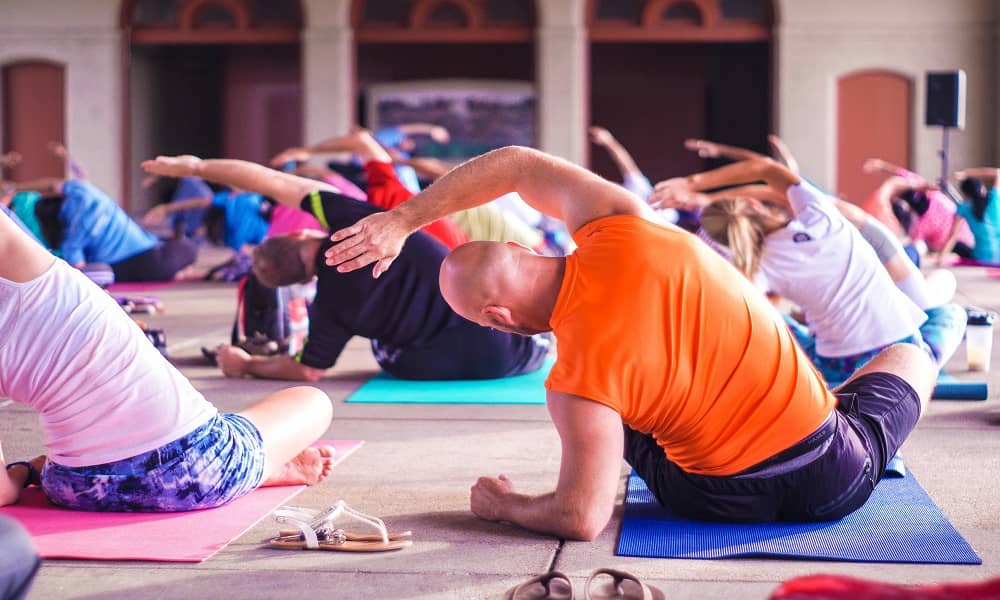


31 Jan Beginner Level Yoga Postures and Stretches for Lower Back Pain
Yoga has been one of the best forms of physical activities for mind-body alignment while offering deep physical therapy. While it’s gentle in practice, some yoga postures can provide a much-needed relief from low back pain.
Back pain is a common complaint among older adults. This is even more true when it comes to the lower back.
Lower back pain is the topmost reason for disability and anxiety among older adults.
Yoga for lower back pain is almost therapeutic in its benefits of deep stretch and muscle relaxation.
However, there’s a fine line here, which you’ve to be mindful of.
Your back is a sensitive part of your body and injuries are all too common, especially if you’re above 60. Thus, it becomes extra important to practice yoga postures in the most effective way possible.
This blog outlines the best yoga Asanas for Lower Back Pain that can help relax your tight muscles and improve posture. Plus, we’ll be taking a look at what kind of precautions you should take to prevent injuries.
First, let’s understand how yoga is beneficial for your lower back.
The Purpose of Choosing Yoga for Lower Back Pain
Posture, controlled breathing, and relaxation are the basics of doing yoga for lower back pain. When done right, it can target the areas where the root cause of your pain resides.
Sitting for extended periods, poor posture, and a weak core are enough to make your troubles multiply.
In such circumstances, Yoga Poses for Lower Back Pain helps:
- Improve posture,
- Stabilize core,
- Improve flexibility, and
- Stretch the muscles in your back
Yoga for Lower Back Pain Relief: Scientific Evidence


There are many forms of yoga disciplines one can choose from, including Iyengar, Bikram, Vinyasa, Yin, Kundalini, and Ashtanga. However, some Yoga Asanas for Back Pain can be especially effective.
Even more so crucial is the fact that yoga has research proving it to be an acceptable cure for back pain relief.
In fact, many clinical guidelines recommend Yoga for Back Pain Relief as an effective non-drug option. Here’s the proof why you must consider yoga for fixing lower back pain.
STUDY 1
According to a study(1) published in the Annals of Internal Medicine, Hatha yoga helped improve lower back pain and activity.
The study involved 320 adults from low-income households with chronic low back pain and divided them into groups.
The Outcome of the Study:
- Participants in the physical therapy group and the yoga group showed similar improvements.
- Both the groups experienced low back pain relief and were also less likely to go for pain medications even after 3 months of participation.
STUDY 2
Another study(2) published in the Journal of Alternative and Complementary Medicine considers hatha yoga to be as effective as conventional therapeutic exercises.
This study was done on seventy people with chronic nonspecific low back pain. 35 patients were put under the yoga treatment and 35 were studied under the exercise plan.
The Outcome of the Study:
- Participants in both groups reported back pain improvement and better functional ability 6 and 12 weeks after the study.
STUDY 3
A study(3) assessed the effects of Iyengar yoga in improving chronic low back pain. The patients were put on an Iyengar yoga therapy.
The Outcome of the Study:
- Participants experienced less back pain after practicing Iyengar yoga for an hour and a half every week for 16 weeks. They also underwent an at-home practice 5 days a week.
Hence, according to these studies, it’s clear that yoga is as effective as any other physical treatment for low back pain.
However, here’s one caveat!
There’s a right way to do anything, and yoga is no exception. The instances of yoga injuries among older adults are pretty high. So, you want to be careful when practicing yoga for lower back pain.
The main aim of doing Yoga Stretches for Lower Back Pain is to relax and not cause the pain to worsen.
This way you’ll be able to release some tension in the tightened muscles without going overboard.
Another Word of Caution:
Start with beginner yoga postures before gradually making your way up to advanced ones. Don’t force anything that your body is not ready for.
With that out of the way, it’s time to take a look at some of the best Yoga Asanas for Back Pain.
Yoga Postures for Your Lower Back Pain
The simplest forms of yoga postures can help you find quick relief.
Experts highly recommend performing some stretches whenever you get time out of your busy schedule. The best part is they are fairly easy to perform and incorporate into your routine.
Plus, these do not require you to use any pre-workouts as these asanas are centered around relaxation and pain relief rather than expending energy.
Though, the number of times you do each asana will depend on your liking. To be extra safe, you may also want to talk to a doctor before starting a new routine.
Having said that, here are the Best Yoga Poses for Back Pain.
Try These Beginner Level Asanas for Instant Relief: Here’s How to Do Each One
#1. Cat/Cow Pose – To Promote Mobility in the Spine






This is one of the best Lower Back Yoga asanas to lengthen the spine and find the space to release tension in the lower back.
- Get on all fours with your hands and knees on the mat.
- Your wrists and knees should align with your shoulders and hips respectively.
- Keep your hands shoulder-distance apart and knees hip-distance apart.
- Inhale and, as you exhale, round your spine and drop the head as you draw your navel towards your spine – the “cat” pose.
- Inhale and lift your head towards the ceiling. At the same time, open your chest as you arch your back – the “cow” pose.
- Repeat this same process 5-10 times.
#2. The Forward Bend – To Stretch Your Spine
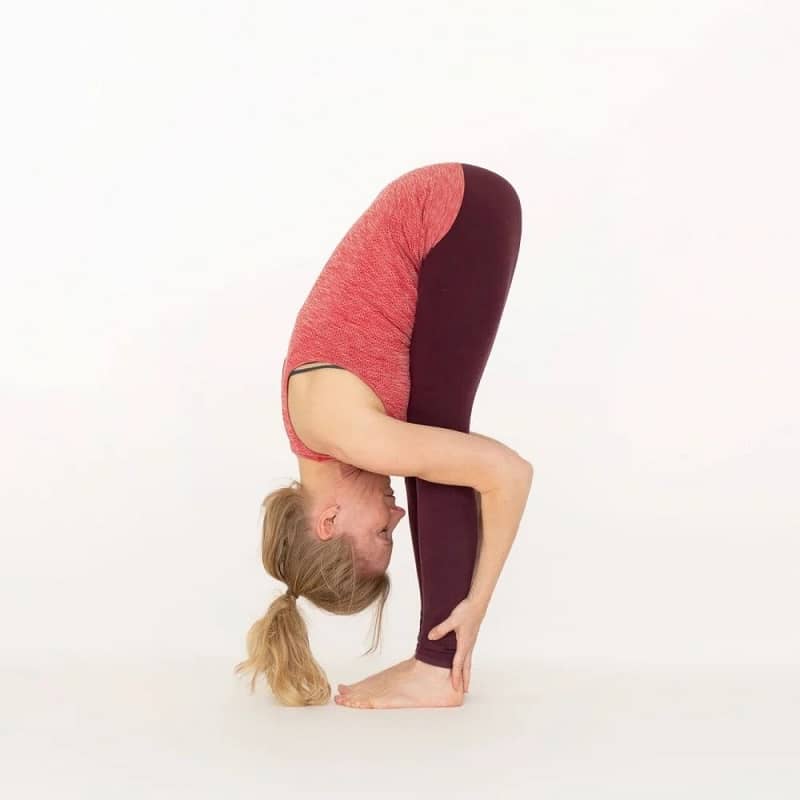


This particular exercise is quite effective at lengthening the spine and back of the legs. However, avoid locking the knees. Instead, keep them a little bent to avoid injury.
- Start by standing upright with your feet hip-distance apart.
- As you inhale, raise both of your arms above your head so that the palms are facing each other.
- Slowly bend the waist and lower your arms out to the side.
- Straighten your legs as much as you can without completely locking the knees.
- Drop your head and torso and relax your shoulders and neck.
- You can also swing your head and arms from side to side to relax into the pose. (No need to force your arms to reach the ground here. If you can reach the ground, good. If you can’t, rest the arms on your shins or on the back of your legs to be comfortable).
- Hold this posture for about 2 minutes with steady breathing.
- Now, to come out of the pose, you can place your hands on your hips and start to slowly straighten your back. Your head should be the last one to unfold and come up. Or you can go straight into a downward-facing dog.
#3. Downward Facing Dog – To Stretch Hamstrings
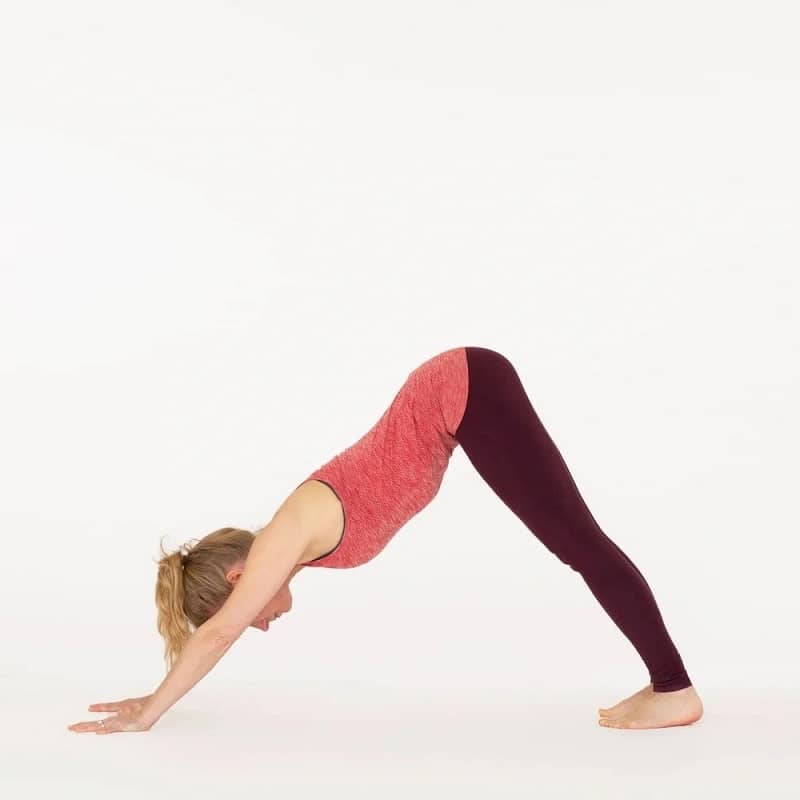


This posture works at stretching your tight hamstrings and calves to relieve any lower back pain linked to your legs.
- From forward bend, slowly step your feet backward on the mat and lift your hips.
- Outstretch your fingers on the mat and press back into the Downward Facing Dog.
- Try to lower your heels towards the ground as much as you can.
- Stretch the arms as you drop your head and gaze towards your belly button.
- Hold this posture for about 1-2 minutes.
- From here, you can again go into forward bend before straightening your back. Or else, you can drop into…
#4. Child’s Pose – To Elongate and Align the Spine
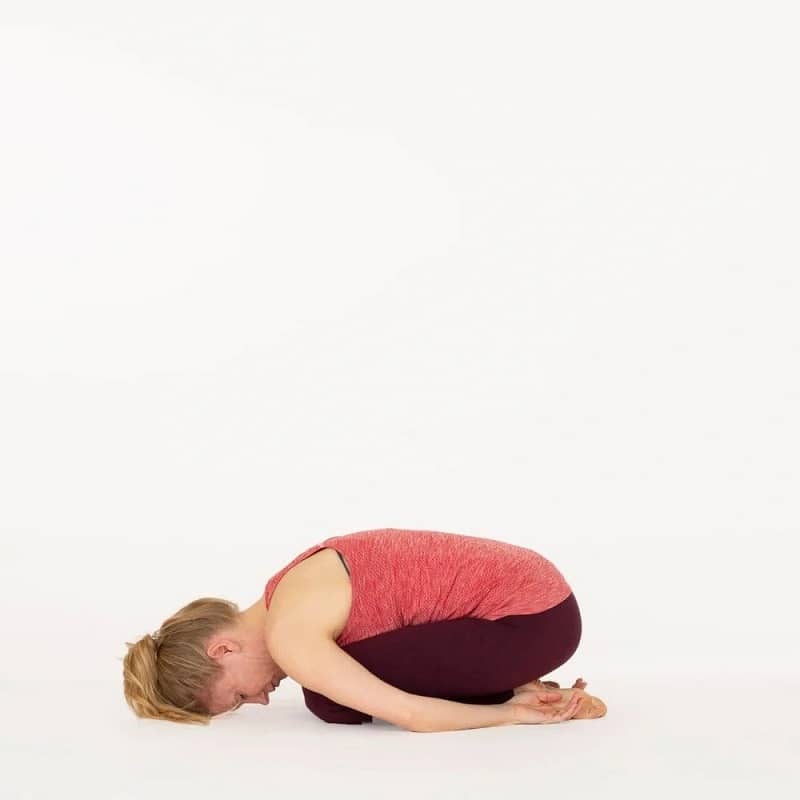


Child’s Pose is literally the best Beginner Yoga for Lower Back Pain. As its name suggests, it requires you to drop down into a fetal position, which gives a nice stretch to your back.
- Transition into the child’s pose from the downward-facing dog by dropping your knees and coming on all fours.
- Then, slowly inhale, and, as you exhale, kneel on your mat with knees hip-width apart.
- Keep your feet together behind you so that they almost touch each other.
- Lay your torso over your thighs and try to stretch your hands on the mat or keep them on the sides.
- Lengthen your neck and spine by drawing your head away from your shoulders as you drop your hips on the heels of your feet.
- Maintain steady breathing while you relax your body in this posture.
- Hold it for 1-3 minutes at a time.
#5. Bridge Pose – To Stretch the Spine and Hip Flexors
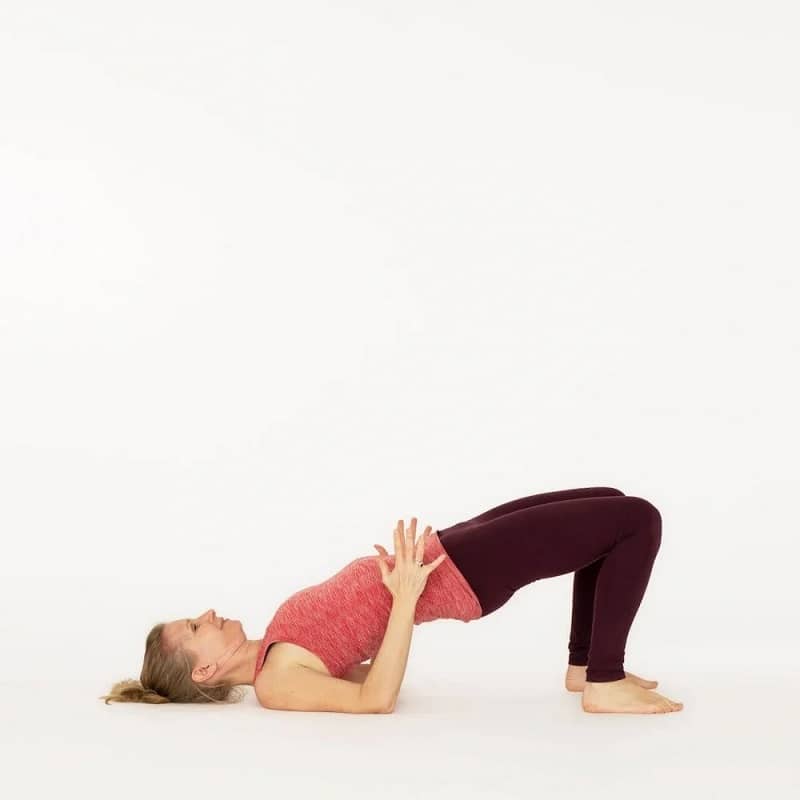


This is an inverted back-bending asana and is a highly effective yoga for lower back pain. Further, it opens the chest and shoulders while offering a deep stretch to your spine.
- Lay on your back with your feet flat on the mat hip-width apart.
- Keep your arms on the sides of your body and palms facing the ground.
- Now, inhale slowly and lift your hips off the floor as you exhale the air out of your lungs.
- Hold it for 2-3 seconds before slowly rolling back down to the floor as you inhale.
- You can repeat it 2-3 times, depending on how comfortable you are.
- It’s best to perform this posture slowly and while maintaining steady breathing.
#6. Knees to Chest Pose – To Stabilize the Lower Back
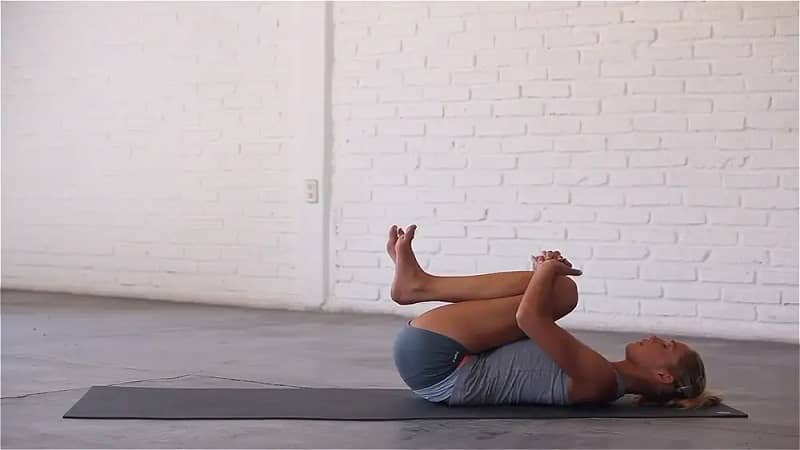


This asana is popularly known as wind-relieving pose and is effective at moving toxins out of the body. At the same time, it’s one of the best Lower Back Yoga poses for relaxation.
You can also choose to perform this at the end of your yoga sequence.
- Lie on your back and draw your knees in towards the chest.
- As you inhale, release the knees slightly away from the chest. Hug them in as you exhale.
- You may also rock side by side to find tension in the back while holding onto your legs.
- Remain in this posture for 1-3 minutes before releasing.
Doing these 6 basic Yoga Poses for Back Pain each day should help improve your symptoms.
Always aim to get comfortable in a posture instead of dropping down into it fast and quick.
Here are some more precautions you can use to stay away from injuries!
Precautionary Tips While Doing Yoga for Lower Back Pain
Yoga is as much a physical exercise as any other form of workout. So, not taking the time to ease into each pose can actually prove detrimental.
- Along with the above-mentioned poses, incorporate asanas to engage and strengthen the core, such as Opposite Hands and Knees Balance.
- Keep your feet parallel while standing in any yoga posture.
- Do not go for extreme twists and extend the spine at the same time.
- Avoid coming up from forward bend with straight legs. This can actually aggravate the pain by compressing the anterior spine discs.
- Try to engage your lower belly and pelvic floor as you come up from a forward fold.
- Use props like blocks and bolsters for additional support in your practice.
Besides performing yoga for lower back pain, being mindful of sitting and standing postures can also be transformative.
If you work a desk job, standing and stretching once in a while is also a preventative measure.
The Takeaway
These yoga poses are specifically aimed at providing quick relief and can be restorative in lower back pain. Most likely, you’ll feel an instant release of some tension in the aching back muscles.
However, as much as exercising is important, you must first find out the exact cause of your pain. If it’s, perhaps, caused by a herniated (slipped) disc, a doctor may advise you against doing yoga.
In usual cases, though, these yoga postures are highly effective and have proven to show results within weeks. It’s even better if you’ve got a yoga instructor or you’ve joined a yoga studio for back pain.
The instructors there can help you figure out your way to better asana modifications in case you face imitations. Even if you’re at home, there’s no need to worry. Just find a comfortable yoga mat and a quiet space to perform your daily practice.
Remember!
Doing yoga for lower back pain may make you a little sore if it’s your first time. However, it shouldn’t cause extreme pain, discomfort, or numbness. It’s crucial to get immediate medical attention if you happen to notice any of these signs.
Post recovery, preventing back pain in the future should incorporate stretching with strengthening exercises. A stable core and back help subdue pain while providing firm muscle support to your spine.
SOURCES:
- Yoga, Physical Therapy, or Education for Chronic Low Back Pain: Saper RB, Lemaster A, Delitto KJ, Sherman PM, et al., July 18, 2017
- Effectiveness of Hatha Yoga Versus Conventional Therapeutic Exercises for Chronic Nonspecific Low-Back Pain: J Altern Complement Med, Sep. 2019
- Effect of Iyengar yoga therapy for chronic low back pain: Pain, May 2005
[isc_list]



No Comments